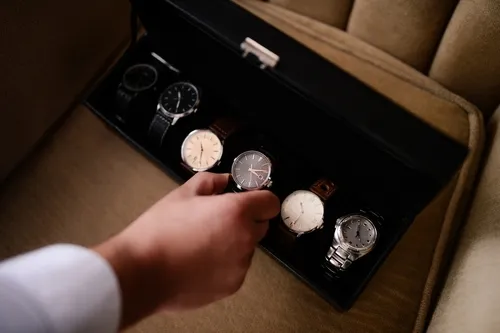Upstox Originals
What’s driving India’s Swiss-watch craze?

7 min read | Updated on August 09, 2025, 18:37 IST
SUMMARY
Indians are falling in love with Swiss luxury watches like never before. What's driving the love for these timeless pieces despite their premium price tags? Will this trend continue in the future as well? Here’s a sneak peek into India’s booming luxury watch market.

For a Patek Philippe Nautilus, there is a wait time of 5 to 8 years
Let us begin this story with an interesting nugget.
Can you guess how much the world’s most expensive watch was sold for?
A million dollars? Maybe five?
The Patek Philippe Grandmaster Chime 6300A-010 was sold for a whopping $31 million, that’s nearly ₹259 crore! Mind-blowing, right?
What’s even crazier is that the company spent over seven years to create this masterpiece. Even Burj Khalifa, the world's tallest building, took only six years to build.
Buyers seem to be obsessed with Patek Philippe watches. For a Patek Philippe Nautilus, there is a wait time of (drumroll please) 5 to 8 years, sometimes even a decade, just to own one.
And that obsession is rapidly finding its way into the growing luxury watch market of India. Interestingly, India has emerged as the fastest-growing market for Swiss luxury watches.
The numbers speak for themselves.
According to the Federation of the Swiss Watch Industry (FH), India imported Swiss watches worth 128.3 million Swiss francs (₹1,226 crore) in H1 2025 (January - June), 113.8 million francs (₹1,086 crore) in 2024 and 98.5 million francs (₹941 crore) in 2023 in the same period. That’s a 12.7% jump in a year and a whopping 30.2% jump over two years!

Source: Federation of the Swiss Watch Industry (FH)
The luxury watch market in India isn’t just growing—it outpaced the top 30 markets worldwide over two years, becoming the fastest-growing luxury watch market.
Today, India is the world’s 21st-largest market for Swiss watches by value.
In fact, India is one of the very few countries to post double-digit growth in H1 2025.
What’s surprising is that India’s growth stands in stark contrast to declines in more mature markets. For context, imports in Thailand dropped by 20.8%, China by 18.7%, Austria by 18.4% and Hong Kong by 13.3%.
The only markets that saw a similar momentum as India were Sweden, which grew by 27.1%, the US by 20.4%, and Spain by 11.8%.
But the question is this: In a cost-conscious country like India, how is the luxury-watch market booming? Also, knowing that India’s per capita income is around ₹2 lakh, how are luxury watches, which start from ₹10 lakh and extend into crores of rupees, finding their way into the Indian market? Let’s find out!
What is driving India’s luxury watch craze?
There was a time when Swiss watches were considered a niche indulgence, but over the years, Indians have developed a strong affinity for these precision-engineered timepieces.
There are several factors pushing the luxury watch market forward in India.
First, India’s economy is growing at a fast pace. Income levels are rising, which is causing a shift in their spending habits. According to a Deloitte report, 60% Indians spend on luxury goods annually, including luxury leather goods, watches, jewelry, eyewear, etc. Earlier, people spent on buying land, gold, or property. But now, the young population, including millennials and Gen Z, prefers to spend on premium products like high-end watches and sneakers, which serve as statement pieces and add to their personality.
Second, the affluent population is expanding rapidly in India (people with annual income of $10,000, i.e. approximately ₹8.6 lakh or more) — almost 12 times faster than in the past four years. They don’t shy away from splurging on high-end luxury items. For them, these timepieces represent style, status and exclusivity. For HNIs (high-net-worth individuals) and UHNIs (ultra-high-net-worth individuals), they serve as a valuable investment asset with the potential to appreciate over time.
Besides, the luxury culture is maturing in India. A luxury watch is more than a status symbol now. It serves as a long-term value purchase, a thoughtful gift and a conscious shopping decision. According to a Deloitte report, 40% Indians choose luxury watches as gifts during weddings and festive seasons. Further, owing to the evolving luxury retail landscape, 70% of people buy watches online as it gives them easy access to international brands. What’s more? Around 30% luxury-watch buyers in India spend over ₹1.2 lakh on a single piece. The numbers show how Indians are increasingly consuming luxury products!
Another interesting statistic from the same report shows that Indians are especially brand-conscious. Nearly 64% of Indian buyers prioritise brand image over price. That’s why luxury Swiss brands like Rolex, Omega, TAG Heuer, Audemars Piguet, Tissot, Franck Muller and Patek Philippe are tapping into India’s rising demand and refined taste.
And last but not least, the recent trade agreement between India and the European Free Trade Association (EFTA) has a huge role to play. According to this agreement, import duties on Swiss watches will reduce from 22% to 0% over the next seven years, starting from September 2025.
That’s a big deal. It will make Swiss luxury watches more affordable and accessible for Indian buyers. Precisely the reason why Switzerland and other EFTA nations are gearing up to invest $100 billion in India over the next 15 years.
All these signs point to strong growth for India’s luxury watch market.
But before we conclude it is a growing market, let us also zoom in on how the market has performed over a decade.
Tracking the momentum of the luxury watch market
We mentioned earlier that Indian buyers aren’t just chasing looks, they’re buying luxury watches for long-term value. According to the Knight Frank Wealth Report 2025, luxury watches have appreciated by 125% over the past ten years, outperforming other passion assets like jewellery, vintage cars, diamonds and art.
But if you take a short-term view of one year, the appreciation was a mere 1.7% in 2024. So, while the long-term trend is solid, short-term returns can be modest. Bonus tip: Before you rush to buy a luxury watch from an investment perspective, remember this market can be volatile in the short term.
The Knight Frank Luxury Investment Index (Q4 2024)
| 1-year % change | 5-year % change | 10-year % change | |
|---|---|---|---|
| Watches | 1.7 | 52.7 | 125.1 |
| Cars | 1.2 | 29.5 | 58.9 |
| Coins | 2.1 | 23.6 | 47.5 |
| Jewellery | 2.3 | 20.2 | 33.5 |
| Colour diamonds | -2.2 | 4.8 | 3.8 |
| Art | -18.3 | 1.9 | 54 |
Source: Knight Frank Wealth Report 2025
Future outlook of India’s luxury market
India’s luxury market is still small by global standards, but it’s rising fast. Bain & Company projects India’s luxury market to reach $85-90 billion by 2030. A Deloitte report forecasts that India's luxury goods market will experience substantial growth, potentially reaching a staggering $200 billion by 2030, with an annual growth rate of 20%. And luxury watches will play a huge role in that ascent.
While India only contributes about 1% to global Swiss watch exports, it has immense growth potential, as seen from its impressive growth trajectory. According to a Deloitte report, Swiss watch exports to India are projected to exceed 400 million Swiss francs by 2028, and India is likely to become one of the top 10 export markets for Swiss watches within a decade.
Following the import duty cuts, the luxury-watch market will only grow stronger in India. So, it’s a market worth watching!
That leaves us thinking — would you buy a luxury watch for style or investment?
By signing up you agree to Upstox’s Terms & Conditions
About The Author
Next Story
